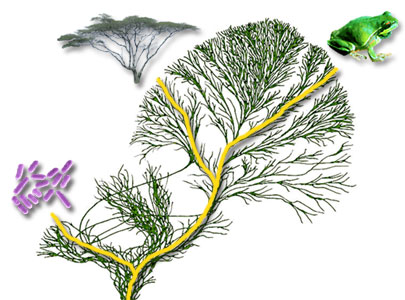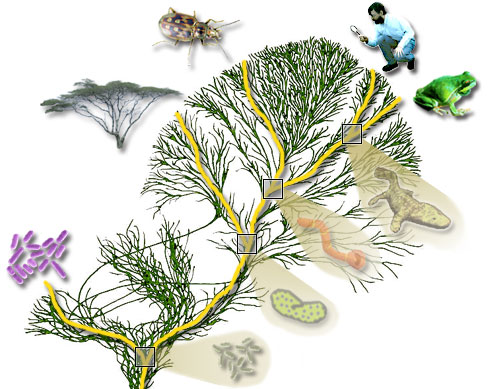What is Phylogeny?
Biologists estimate that there are about 5 to 100 million species of organisms living on Earth today. Evidence from morphological, biochemical, and gene sequence data suggests that all organisms on Earth are genetically related, and the genealogical relationships of living things can be represented by a vast evolutionary tree, the Tree of Life. The Tree of Life then represents the phylogeny of organisms, i. e., the history of organismal lineages as they change through time. It implies that different species arise from previous forms via descent, and that all organisms, from the smallest microbe to the largest plants and vertebrates, are connected by the passage of genes along the branches of the phylogenetic tree that links all of Life (Figure 1).

Figure 1: All organisms are connected by the passage of genes along the branches of the phylogenetic Tree of Life.
The organisms that are alive today are but the leaves of this giant tree, and if we could trace their history back down the branches of the Tree of Life, we would encounter their ancestors, which lived thousands or millions or hundreds of millions of years ago (Figure 2).

Figure 2: Living organisms sit like leaves at the tips of the branches of the Tree of Life. Their evolutionary history is represented by a series of ancestors which are shared hierarchically by different subsets of the organisms that are alive today.
The notion that all of life is genetically connected via a vast phylogenetic tree is one of the most romantic notions to come out of science. How wonderful to think of the common ancestor of humans and beetles. This organism most likely was some kind of a worm. At some point this ancestral worm species divided into two separate worm species, which then divided again and again, each division (or speciation) resulting in new, independently evolving lineages. Little did these worms know, those hundreds of million years ago, that some of their number would end up evolving into beetles, while their brothers and sisters would end up as humans or giraffes.
Organisms have evolved through the ages from ancestral forms into more derived forms. New lineages generally retain many of their ancestral features, which are then gradually modified and supplemented with novel traits that help them to better adjust to the environment they live in. Studying the phylogeny of organisms can help us explain similarities and differences among plants, animals, and microorganisms. The Tree of Life thus provides a rigorous framework to guide research in all biological subdisciplines, and it is therefore an ideal model for the organization of biological knowledge.
 Go to quick links
Go to quick search
Go to navigation for this section of the ToL site
Go to detailed links for the ToL site
Go to quick links
Go to quick search
Go to navigation for this section of the ToL site
Go to detailed links for the ToL site